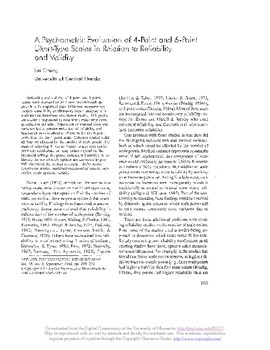
The associations were largely identical, with the exception of an increase in explained variance when predicting age from the VAS version of Excitement Seeking (B10 = 1318.95, ΔR(2) =. Both response scales showed a high overlap and the proposed relationships with age and gender. To assess the validity of the measurements, age and gender were used as criteria, because all three constructs have shown non-zero correlations with age and gender in previous research. Results show comparable reliabilities, means, and SDs for the VAS versions of the original scales, in comparison to Likert-type scales. The questionnaire contained all instruments in both answer scale versions in a counterbalanced design.

A sample of 879 participants filled out an online questionnaire measuring Conscientiousness, Excitement Seeking, and Narcissism. The present study expands the comparison of response scales to properties of Internet-based personality scales in a within-subjects design. Visual analogue scales (VASs) have shown superior measurement qualities in comparison to traditional Likert-type response scales in previous studies. Kuhlmann, Tim Dantlgraber, Michael Reips, Ulf-Dietrich Investigating measurement equivalence of visual analogue scales and Likert-type scales in Internet-based personality questionnaires. Some 138 variables in 3 factors and 40 affirmations were simplified. A One-way Analysis of Variance (ANOVA was used, with statistical package SPSS. The Likert measurement scale was used because it allowed to establish the pertinence of the dimension as variable in the context of organizational learning. Organizational learning, pilot test of Likert-type instrumentsĭirectory of Open Access Journals (Sweden)įull Text Available This paper presents the results obtained in the pilot study of instruments created to comply the specific objective of designing and validating instruments to study the capacity of organizational learning.


 0 kommentar(er)
0 kommentar(er)
